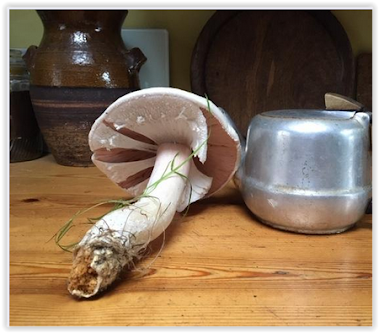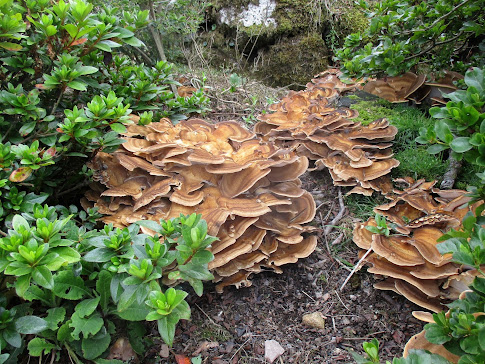FALLING LEAVES
The recent chilly nights are making the trees turn colour. Sitting in the car as an ‘elf an safety back-up' for Tony as he did his monthly ‘kick sample’ in the River Seaton for the national Riverfly Survey to monitor water quality, my eye was caught by the steady trickle of leaves fluttering to the ground.
It took me back to the rainforests of northern Queensland where the deep silence was punctuated only by the whisper of the constant trickle of falling leaves and the occasional strident call of an unseen bird high up in the canopy.
Most of the huge variety of species of trees in a tropical rainforest are evergreen so the renewal of their leaves goes on all through the year. To a stranger, so many of the leaves look the same. Medium-sized, plain oval and leathery, they are invariably nibbled by caterpillars. Everything rushes upwards to such light as penetrates the canopy. Scarcely a tree is without its burden of ferns growing in crevices in the bark. Vines wrap and cling to the tree trunks, sending long straight lianas hanging down like climbers’ abseil ropes.
 |
| Rainforest, northern Queensland. |
The forest floor has a thin scatter of dead leaves. But the subdued light means there isn’t much ground flora. There is a network of tree roots running over the surface, spreading far and wide from the buttress base of the forest giants.
 |
| Buttress of forest giant. Its main roots ran for 20 metres before disappearing below the surface. |
These narrow upright supports may be the height of a person but less than a couple of inches thick. Clearings made by a big fallen tree let the sunlight in, and give a chance for a great surge of plant growth, from herbaceous flowers to tree saplings. Butterflies take advantage of the sun and flit high among the leaves. It is a thrill to see the electric blue of a Ulysses or the narrow green, black and yellow wings of a Cairns Bird-wing.
 |
| The inelegantly-named Egg Fly. Most of the big showy butterflies are too high up in the canopy for my little 'up and fire' camera to cope. |
 |
| Fungi of all kinds grow in the leaf litter. |
The fallen trunks are rapidly decayed by troops of fungi and we’ve had lucky views of Echidnas tearing at the rotting wood with their long claws and poking their snout into the debris to lick up disturbed ants and other invertebrates with their long sticky tongues. These dumpy animals with stout brown and black spines are an Australian oddity, an egg-laying mammal!
 |
| Echidna. It is nearly the size of a badger but much smaller under all those stout spines. |
Small Sweat Bees, always ready to settle and drink the perspiration off your skin in the hot sultry conditions, are an irritant, but at least they don’t bite or sting. Unlike the big pale red ants which process up into the trees, each carrying a piece of freshly-cut green leaf, to help construct their nest, as big as a rugby ball, slung up in a high branch.
 |
| Nest of tree ants. They bind the leaves together with silk threads woven by their larvae. I think with hindsight, the fragments of leaves they carry to the nest may be to feed the larvae. |
Bird calls of all kinds sound loud and clear, usually from individuals neck-breakingly high up in the canopy. The whip-crack sound of a Whip-bird is immediately followed by the two-note response from its mate. The melodious fluting song of a Pied Butcherbird or the abrupt cackle of a Blue-winged Kookaburra, are immediately recognizable. This latter big lizard-feeding kingfisher is the tropical brother of the much loved Laughing Kookaburra often seen and heard further south in the country.
 |
| Pied Butcherbird. |
Given away by a pretty downward series of silvery notes, a tiny greenish Gerygone, one of the leaf warblers has a characteristic downward –tumbling flight among the leafy twigs, and flitting from truck to trunk, robins of the northern forests, including both Yellow-breasted and the jaunty Red-capped Robins, settle tantalizingly just round the corner of a tree trunk, to fly briefly to the ground to pick something up to eat.
Northern Logrunners or Chowchillas live up to their name. Brown birds the size of a Blackbird, they poke around in the shadows of rotting logs, giving fleeting glimpses.
Small birds can be seem in the clearings. Honeyeaters, a large group of Australian birds with long curved beaks enabling them to reach the nectar in flowers, can be challenging to identify as they flit among the foliage.
A special group of ground-dwelling birds, the common Brush Turkey and more elusive Scrub Fowl, build great mounds of leaves which make a sort of warm compost heap in which they lay a large clutch, leaving the warmth of the rotting leaves to incubate the eggs. They are very vulnerable to marauding goannas which will dig them out. If they are lucky enough to escape these attentions they will take up to seven weeks to hatch, but then the chicks are immediately able to run around and feed themselves.
Brush Turkey. We ate one freshly-killed on the road. They are reputed to be extremely tough. Ours wasn't, but it was full of sharp sinews.
 |
| Scrub Fowl, difficult to spot especially for the camera, in the gloom of the forest. |
The cathedral-like hush of the rainforest is home to swarming activity all around.
The sudden opening of the car door brought me out of my reverie with a jolt. Tony had come back with a bucket of sample water and a dripping net, and I was no longer in Queensland.......
Thanks to daughter Kim for using one or two pages from her field drawings (the Logrunner and the page with the Yellow Honeyeater.) They do better justice than our ageing slides.









































